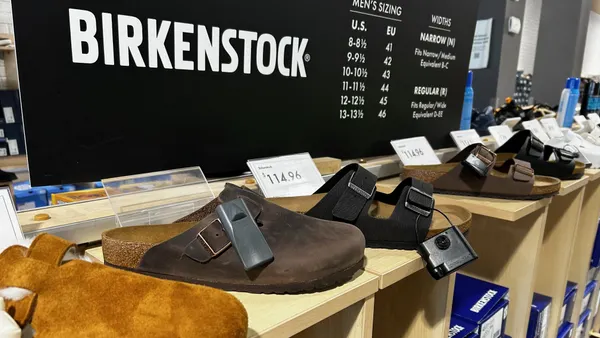UPDATE: April 2, 2018: In a statement emailed to Retail Dive, an Amazon spokesperson pushed back on the methodology of the Gartner L2 report, calling it "flawed and selective." Amazon heavily invests "both funds and company energy" to ensure its policy against counterfeits is being upheld, the spokesperson said, adding, "We track every instance of customers using words like 'fake' or 'not real' in customer feedback, and use that and other information to identify and remove inauthentic products and the bad actors trying to list those products. In the US, more than 99.99% of units sold have had no customer feedback regarding counterfeit concerns."
Dive Brief:
-
While upscale brands have made the loudest noise about knockoffs sold by third-party sellers through Alibaba, Amazon and others, lower-priced brands on Amazon may be more vulnerable because of their greater presence on its marketplace, according to research from e-commerce insights firm Gartner L2 emailed to Retail Dive.
-
The top-selling products on Amazon are priced under $50, and that makes low- to mid-priced brands prime targets of unauthorized distribution, according to the report.
-
Customer claims of counterfeiting are widespread on Amazon: A third of all unique products listed by third-party merchants garner a review that calls the product, often a fashion or beauty item, a "fake" or "counterfeit," Gartner L2 found.
Dive Insight:
Historically, knockoffs of highly desirable items were a fixture of gritty street sales all over the world. New York City’s Canal Street area and swaths of other big cities long hosted hustling vendors who sold fakes. While there may have been a few naive shoppers who thought they were really getting a too-good-to-be-true deal on something authentic, most just enjoyed the hunt for cheap bags or sunglasses that would pass muster.
Local politicians and customs officials cracked down more than a decade ago on the practice on the street, thanks to pressure from designers and high-end retailers, to the point where Canal Street today is increasingly becoming a shopping destination for the real things.
Today, the pinnacle of counterfeit sales is e-commerce — particularly third-party marketplaces populated by hundreds of small sellers, where counterfeiters can more easily fool shoppers and evade detection by regulators and the marketplaces themselves. Of the categories evaluated by Gartner L2 on Amazon, women’s handbags and wallets, men’s shoes, and makeup have the highest number of third-party sellers, with over 90% of assortment owned by third-party vendors.
And while Amazon has worked to combat counterfeit sales of luxury beauty brands, it's done little for high-end brands in other categories, and less for lower-priced brands.
"Low- to mid-priced fashion and makeup brands have a disproportionate number of third-party sellers managing their top-selling assortments on Amazon and should reconsider how much control they want to outsource," the researchers warned, adding that brands contemplating sales through Amazon's marketplace should consider taking control of sales and distribution themselves.
Gartner L2 analyzed more than 350,000 Amazon reviews written between 2016 to 2018 across 4,280 Amazon Standard Identification Numbers. So-called ASINs (unique identifiers used by Amazon) were chosen based on whether a third-party vendor owned the buy box. Researchers picked customer reviews with one- and two-star ratings where reviews included keywords like "counterfeit" or "fake," according to the report.
According to the Amazon spokesperson, Amazon uses machine learning and automated systems to detect "bad actors and potentially counterfeit products." The company's anti-counterfeiting program also employs teams of software engineers, research scientists, program managers and investigators.
"When a business registers to sell products through Amazon’s Marketplace, Amazon’s systems scan information for signals that the business might be a bad actor, and Amazon blocks identified bad actors before they can offer any products for sale," the spokesperson said, according to the statement. "Amazon’s systems also automatically and continuously scan numerous data points related to sellers, products, brands and offers to detect activity that indicates products offered might be counterfeit. Over 99.9% of all Amazon page views by our customers landed on pages that did not receive a notice of potential infringement."














